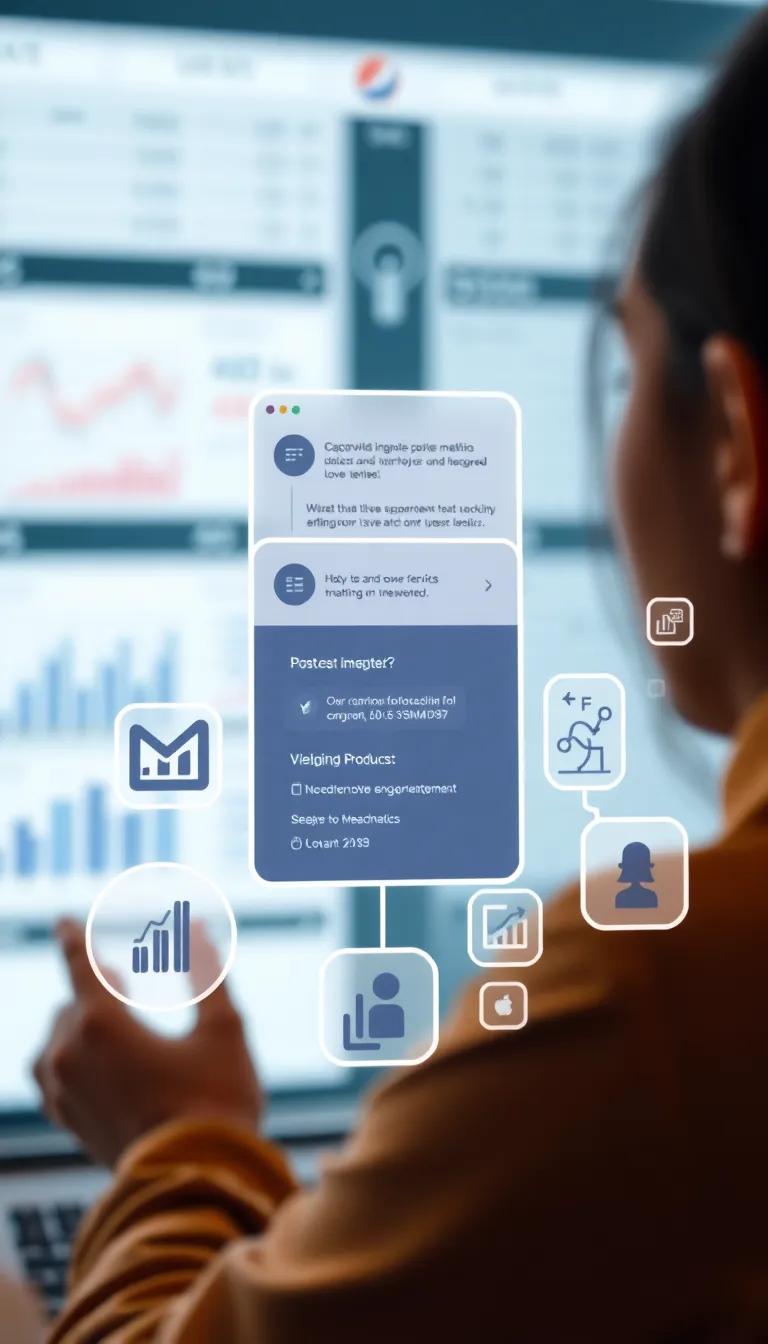Introduction
Engagement metrics are vital for understanding how your website visitors interact with your content, especially when using tools like a chat widget. This article discusses the importance of tracking these metrics to gauge user satisfaction, improve service efficiency, and drive conversions. By utilizing engagement metrics, businesses can analyze visitor behavior, leading to enhanced customer experiences and increased loyalty.
A website chat widget serves as a direct line of communication between businesses and their customers, facilitating real-time support and engagement. Understanding how to track success through engagement metrics will help ensure that your chat widget not only meets customer expectations but also amplifies your online presence. Businesses can leverage these insights to refine their strategies and optimize chat interactions, making them more effective.
Understanding Engagement Metrics Their Importance in Online Interactions
Engagement metrics represent a collection of quantitative data points that assess how users interact with a digital platform, such as a website. In the context of online interactions, these metrics serve as vital indicators of user behavior, revealing significant insights into the effectiveness of a business’s online presence. Companies utilize various engagement metrics to evaluate the performance of their web content, customer service strategies, and marketing campaigns, particularly through tools like chat widgets.
Among the primary engagement metrics are session duration, page views per visit, bounce rate, and conversion rate. Each of these metrics provides distinct insights: session duration measures how long users remain engaged on a site; page views per visit reflects the extent to which users explore different sections; bounce rate indicates the percentage of visitors leaving without engaging further, and conversion rate reveals how many users complete desired actions, such as making a purchase or signing up for a newsletter.
Understanding these metrics has far-reaching implications for businesses. For example, a low session duration may indicate that users are not finding the content compelling enough to stay, prompting a review and possible revision of web design or content strategy. Conversely, a high conversion rate could signal that user engagement strategies, including the use of chat widgets, are successfully resonating with the target audience.
The significance of engagement metrics extends beyond internal assessments. They also play a crucial role in fostering customer relationships. By carefully analyzing these metrics, businesses can tailor their offerings to meet customer expectations and adapt their communications accordingly. For instance, if engagement metrics show that users are frequently interacting with a chat widget, businesses can leverage this insight to enhance customer service, providing timely and personalized responses that increase satisfaction and loyalty.
Engagement metrics not only evaluate user interaction but also empower businesses to refine their strategies, connect with customers more meaningfully, and ultimately track success effectively. Through the prudent monitoring and analysis of these metrics, companies can better understand audience preferences and behaviors, guiding their future marketing and engagement efforts.
The Role of Chat Widgets in Customer Engagement
Enhancing Customer Interaction through Chat Widgets
Chat widgets have emerged as an instrumental tool in augmenting customer engagement on websites. They facilitate real-time communication, enabling businesses to connect with their audience in a more personalized manner. By integrating chat widgets, brands can initiate conversations that not only provide answers to customer inquiries but also foster a deeper relationship with potential and existing clients.
These widgets serve several purposes, dynamically improving the overall customer experience. First, they offer immediate support, which is critical in today’s fast-paced environment. Instantaneous responses can significantly enhance user satisfaction, reducing bounce rates and encouraging visitors to stay longer on the site. This immediate feedback loop is essential for keeping users engaged and can substantially influence purchasing decisions.
Chat widgets can be tailored to align with a brand’s voice and style. This personalization aspect allows businesses to communicate in a way that resonates with their audience, making interactions feel genuine and thoughtful. A chat widget can also gather customer preferences and feedback in real time, providing invaluable insights that influence marketing strategies and product development.
Another significant aspect of chat widgets is their ability to track engagement metrics. By analyzing how users interact with the chat feature, businesses can glean essential data points such as average response times, the number of initiated conversations, and common inquiries. This information can help companies make informed decisions about staffing, improving response protocols, and even creating FAQ sections based on frequently asked questions. The ability to monitor these metrics enables businesses to refine their strategies continually.
For instance, if a visitor hesitates on a product page, a chat widget can pop up to offer assistance. This proactive approach not only boosts engagement but can also lead to conversions that may have otherwise been lost.
Chat widgets are more than just a communication tool; they are a comprehensive approach to customer engagement. By utilizing these widgets effectively, businesses can track significant engagement metrics, deepening interactions and cultivating a more engaging online environment.
Tracking Success Engagement Metrics in Action
Understanding Engagement Metrics
Engagement metrics are vital for assessing the performance of a chat widget on your website. These metrics provide insight into customer interactions, helping businesses understand user behavior and preferences. Monitoring these metrics effectively can help track the success of your chat widget and enhance customer engagement. Key metrics to observe include user participation rate, average response time, conversation duration, and customer satisfaction scores. Having a clear understanding of these metrics allows for informed decision-making in improving the user experience.
Practical Steps for Tracking Engagement Metrics
To successfully track engagement metrics associated with your free website chat widget, follow these practical steps:
- Implement Analytics Tools: Begin by integrating analytics tools with your chat widget. These tools can track visitor interactions and provide valuable data. Choose options that specialize in real-time analytics to monitor live chat activity.
- Define Key Performance Indicators (KPIs): Identify specific KPIs that reflect your business goals. Common KPIs include user engagement rates, successful chats converted into leads, and overall customer satisfaction ratings. Having defined standards will allow for focused monitoring.
- Monitor User Engagement Rates: Track the number of users engaging with the chat widget. This measure can help determine how effectively your chat feature attracts visitors. Analyzing peak usage times can also inform timing adjustments for proactive engagement.
- Evaluate Response Times: Evaluate the average response time of the chat widget. A quick response time often correlates with better customer satisfaction. Use this data to optimize staffing or chatbot efficiency during busy periods.
- Collect Customer Feedback: Make it easy for customers to provide feedback post-interaction. Short surveys can be embedded within the chat experience. This feedback directly correlates with customer satisfaction and helps identify areas for improvement.
- Analyze and Adjust: Regularly review the collected data to identify trends and changes in engagement. Adapt your strategies based on these insights, focusing on enhancing features that users find valuable and refining those that show lower performance.
By diligently following these steps for tracking engagement metrics, businesses can cultivate a more effective chat widget experience, thereby fostering deeper customer interactions that lead to increased satisfaction and loyalty.
Using Engagement Metrics to Drive Improvements
Leveraging Insights for Enhanced Chat Widget Performance
Leveraging engagement metrics has become a powerful strategy for businesses seeking to enhance their chat widget performance. By analyzing the data collected from user interactions, businesses can identify strengths and weaknesses within their current approach. This process begins with defining key engagement metrics that directly correlate with chat widget efficiency.
Understanding customer satisfaction levels is paramount. Metrics such as the Customer Satisfaction Score (CSAT) and Net Promoter Score (NPS) provide insight into how users perceive their chat experience. Tracking these scores over time allows businesses to pinpoint areas that require attention. For instance, consistent low scores may indicate that users struggle with response times or find automated responses insufficient. By addressing these concerns, businesses can improve their chat interface and respond more effectively to user needs.
Another critical metric is engagement rate, which indicates the percentage of visitors interacting with the chat widget. Observing when and how frequently users engage can reveal patterns in behavior. Are there specific times of day or certain web pages that yield higher interaction rates? Understanding these patterns allows businesses to optimize chat widget placement and timings. For example, if engagement spikes during certain hours, businesses can ensure that representatives are available to respond actively during those peak times.
Measuring conversation duration is also insightful; if interactions are cut short, it could imply that users are not receiving the information they seek. Analyzing this metric alongside common questions can help businesses refine the chat script and FAQ resources. Providing users with precise and valuable information can enhance the overall interaction quality, ultimately leading to higher conversion rates.
Retention and conversion metrics are vital in determining the return on investment from the chat functionality. By comparing engagement metrics before and after implementing changes based on insights, organizations can quantify the impact of their strategies. Tracking user journeys through the chat interface can also provide data on whether these interactions result in successful sales or lead conversions.
Utilizing engagement metrics to inform improvements in a chat widget is a multifaceted approach. From understanding customer satisfaction to optimizing timing and content, these metrics provide actionable insights that can dramatically enhance customer interaction and drive business success.
Case Studies of Successful Chat Widget Use
Leveraging Engagement Metrics for Growth
Many businesses have harnessed the power of chat widgets complemented by engagement metrics to drive significant growth and enhance customer interactions. By analyzing user interactions, these companies have made data-driven decisions that truly resonate with their clientele. Below are a few noteworthy examples that showcase the effectiveness of this combination.
The first case is that of a leading e-commerce platform. Utilizing a free chat widget, the company implemented engagement metrics to assess customer queries in real time. By tracking metrics such as response time, resolution rate, and user satisfaction scores, they were able to fine-tune their customer service approach. The results were staggering: within just three months, they noticed a 25% increase in customer satisfaction ratings and a 15% boost in sales conversion rates. The responsiveness fostered through the chat feature not only addressed customer inquiries instantaneously but also led to upselling opportunities thanks to the insights gathered from interactions.
Another example comes from a popular online education provider. They integrated a chat widget to assist prospective students with course inquiries. By scrutinizing engagement metrics, such as the number of chats initiated and the average duration of conversations, the team identified frequent concerns that prospective students had. They used this data to improve their FAQs and tailored their marketing campaigns to address these specific questions. The outcome was impressive; there was a 30% increase in enrollment rates attributed to improved customer engagement, driven by a thorough understanding of potential students’ needs.
In the hospitality industry, a boutique hotel leveraged chat widgets to enhance guest experience before arrival. By analyzing engagement metrics, they pinpointed preferences in room types and amenities through direct interactions with potential guests. Using this information, the hotel personalized marketing efforts and recommended tailored packages. This strategy resulted in a notable rise in bookings and repeat customers, demonstrating how critical understanding client interactions can be. Additionally, they collected post-stay feedback directly through the chat widget, facilitating continuous improvement in guest services.
Through these examples, it becomes evident that integrating chat widgets with robust engagement metrics creates immense potential for growth. Businesses not only enhance interactions with customers but also gain vital insights that drive strategic decisions geared towards meeting market demands effectively.
The Future of Engagement Metrics and Chat Widgets
Predicting Trends in Engagement Metrics
The landscape of engagement metrics and chat widgets is undergoing significant transformation, poised to greatly enhance customer experiences and interaction models. As technologies advance, businesses will find themselves examining a data-rich environment where every engagement can yield crucial insights. The future of these metrics will not solely revolve around quantifying interactions but will increasingly emphasize understanding context, sentiment, and intent. Tools harnessing artificial intelligence are expected to become ever more sophisticated, enabling businesses to derive actionable insights from real-time conversations.
Attention will shift toward metrics that reflect genuine engagement rather than mere volume. For instance, businesses might focus on time spent in a chat or the complexity of inquiries made rather than the number of chats initiated. Additionally, aspects such as customer satisfaction scores gathered post-interaction will play a central role in tracking success, providing richer data that correlates directly to customer loyalty and retention.
The Evolution of Chat Widgets
As engagement metrics evolve, chat widgets will likely follow suit, transforming to meet the changing demands of users. Future chat widgets might incorporate advanced functionalities such as voice interaction capabilities and even AI-driven responses that adapt based on prior interactions with users. Enhanced personalization will become a hallmark of future chat interfaces, creating a seamless experience that recognizes users’ preferences and histories, ultimately fostering deeper connections.
The integration of chat widgets within social media platforms and other digital communities will become commonplace. This convergence will allow businesses to engage with customers where they already spend their time, increasing the likelihood of meaningful dialogues. Extending functionality beyond traditional chat—such as offering multimedia support or facilitating in-chat purchasing—could redefine how businesses interact with their customers through these tools.
As these widgets become increasingly vital in the customer interaction paradigm, the metrics that gauge their success will also diversify. Brands will likely leverage new metrics related to integration efficiency and cross-channel behavioral tracking. The future points toward a more interconnected web of customer engagement where chat widgets serve as a hub, thereby requiring marketers to rethink their strategies in harnessing these powerful tools for relationship-building and conversion optimization.
Conclusions
Engagement metrics for free website chat widgets offer a wealth of insights into customer behavior and preferences. By consistently monitoring these metrics, businesses can adapt their strategies to enhance customer experiences and drive higher engagement rates. The implications are profound: improved interactions can lead to better customer satisfaction and increased conversion rates.
Leveraging engagement metrics transforms how businesses connect with their customers. Understanding what drives engagement and satisfaction enables companies to not only meet but exceed customer expectations, solidifying their position in an increasingly competitive landscape. As online communication evolves, those who effectively utilize these metrics will stand to gain a significant advantage.

















